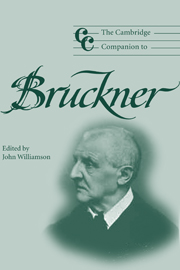Book contents
- Frontmatter
- Part I Background
- Part II Choral music
- Part III The symphonist
- 7 The Brucknerian symphony: an overview
- 8 Bruckner's symphonies – a reinterpretation: the dialectic of darkness and light
- 9 Programme symphony and absolute music
- 10 Bruckner editions: the revolution revisited
- 11 Bruckner and the symphony orchestra
- 12 Between formlessness and formality: aspects of Bruckner's approach to symphonic form
- 13 Formal process as spiritual progress: the symphonic slow movements
- 14 Bruckner and harmony
- Part IV Reception
- Notes
- Select bibliography
- Index
13 - Formal process as spiritual progress: the symphonic slow movements
from Part III - The symphonist
Published online by Cambridge University Press: 28 September 2011
- Frontmatter
- Part I Background
- Part II Choral music
- Part III The symphonist
- 7 The Brucknerian symphony: an overview
- 8 Bruckner's symphonies – a reinterpretation: the dialectic of darkness and light
- 9 Programme symphony and absolute music
- 10 Bruckner editions: the revolution revisited
- 11 Bruckner and the symphony orchestra
- 12 Between formlessness and formality: aspects of Bruckner's approach to symphonic form
- 13 Formal process as spiritual progress: the symphonic slow movements
- 14 Bruckner and harmony
- Part IV Reception
- Notes
- Select bibliography
- Index
Summary
Notions of genre have a stubborn persistence. As recently as 1950, Bernhard Paumgartner wrote of the symphony's continuing significance, in the ‘postwar cultural confusion’ of his own time, as ‘a monumental art performed by a multitude of players before a still greater multitude of listeners’. The concept of symphonic monumentality – sometimes interpreted as having to do with the sheer magnitude of a work but more complex than that, as we shall see – has special relevance to Bruckner, as do other assumptions about genre that come up in Paumgartner's remarks. After having separated musical genres into the communal and the purely private (the latter exemplified by the lullaby), he divided communal music into three basic categories and then asserted that the various movements within the symphony showed the imprint of all three. That is to say, Paumgartner discerned traces of primordial communal functions in each type of symphonic movement: of martial or of ceremonial state music in the first, of dance music in the minuet or scherzo and also in the finale. And in the ‘emotional significance’ of the slow movement he heard a residue of the sounds and spirit of music used in religious rites.
Nowhere has the connection between the genre of the symphonic slow movement, in particular the symphonic Adagio, and religious experience been noted more often, it seems, than in treatments of Bruckner's lifework. August Halm, for example, called the Adagio not just the ‘central movement’ but the ‘shrine’ in his symphonies, adding that this had nothing to do with whether the character of the melodies sounds ‘ritualistically religious’. He wrote that Bruckner was in fact as likely to place a melody reminiscent ‘of the chorale or even of chant or the hymn’ in an opening movement or finale as in an Adagio. What Halm saw as of primary importance was that ‘for the construction of the Adagio he established a more regular rule – thus, more or less a ritual’.
- Type
- Chapter
- Information
- The Cambridge Companion to Bruckner , pp. 190 - 204Publisher: Cambridge University PressPrint publication year: 2004
- 1
- Cited by

